This Review Covers:
- Overview
- What Do Users Like About Zoho?
- What Don’t Users Like About Zoho?
- What Pricing Plans Does Zoho Offer?
- What are the Standout Features of Zoho?
- Selected Positive User Feedback
- Selected Negative User Feedback
- What are Zoho’s Ratings from Review Sites?
- What’s My Final Verdict on Zoho?
Overview
Zoho is a comprehensive suite of cloud-based software applications that offer solutions to a wide range of business needs. It offers over 50 different applications that cover various functions such as accounting, marketing, customer relationship management, project management, HR management, and more.
What I’ll discuss here are Zoho’s time tracking features such as timers, online timesheets, automated time tracking, and real-time attendance monitoring which are to be found mostly in Zoho Invoice, Zoho Projects, Zoho Shifts, and Zoho People.
Using Zoho’s various time tracking features, businesses can easily manage employee time and attendance, stay on top of scheduling, and track project time and expenses.
Along with generating accurate timesheets for payroll processing, it generates some pretty crisp reports, allowing businesses to analyze employee time data, identify trends, and make informed decisions about resource allocation and productivity.
I particularly love Zoho’s user-friendliness and exceptional customer support that complement its array of features that facilitate productivity enhancement, efficiency, and collaboration.
I also love the way its interface is designed – not too cluttered, yet not too sterile either. And the way it can be customized to fit unique needs such as with custom workflows and custom forms is quite thoughtful, too.
However, I do have some concerns about Zoho, and foremost is the way both iOS and Android apps freeze or crash when clocking in and out. This and other bugs and glitches plaguing both mobile and desktop versions compromise the precision of its time tracking functionality and spell trouble for all the processes dependent on captured time data.
In addition, the software’s calendar functionality isn’t as smooth as I’d like it to be either – it doesn’t update in real time, which is quite a bummer for a feature that’s meant to keep everyone informed about any changes immediately.
The pre-built reports, while great for saving time in creating routine and simple reports, don’t quite offer the precision and analytic power I usually need. It could do better with more customizability and complexity.
Now, that’s just the tip of the iceberg, and it’s only fair that we explore what else it has to offer in detail before making any judgments. So, without further ado, let’s dive right into it!
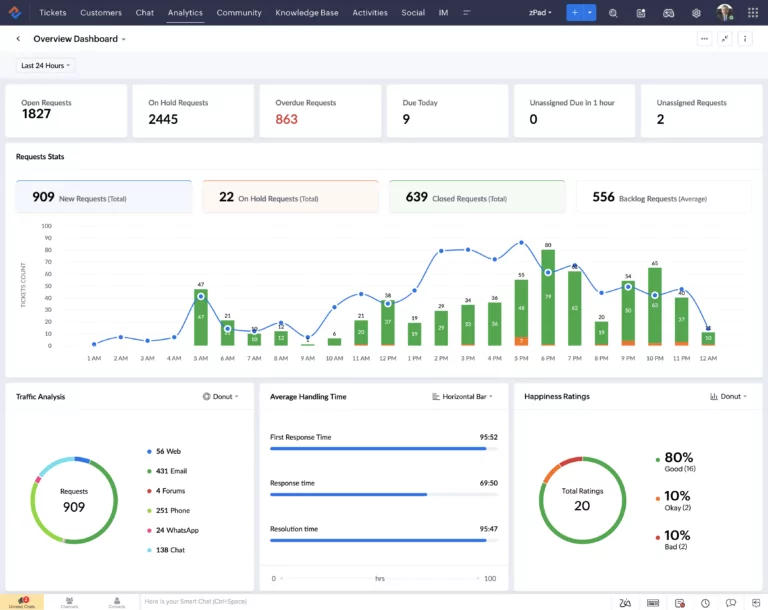
(zoho.com)
What Do Users Like About Zoho?
- Easy to set up
- Easy to use
- Attractive interface
- Customizability to fit unique workflows
- Responsive customer support
Find more on what users love about Zoho.
What Don’t Users Like About Zoho?
- Doesn’t fully integrate with other apps, even those from Zoho
- Mobile app crashes and freezes
- Bugs and glitches compromise time tracking
- Calendar issues
- Reports need more precision and customizability
- Pricing is steep and advanced features drive the price up
Find more on what users hate about Zoho.
What Pricing Plans Does Zoho Offer?
At the beginning of this Zoho review, I mentioned that time tracking features are most prominent in, Zoho Projects, Zoho Shifts, and Zoho People, so we’re looking at the pricing plans of all three apps. We’re also looking at what the plans are designed for, the features they have for each plan, and how they compare to each other.
Zoho People
Zoho People offers five pricing tiers: Essential HR, Professional, Premium, Enterprise, and People Plus.
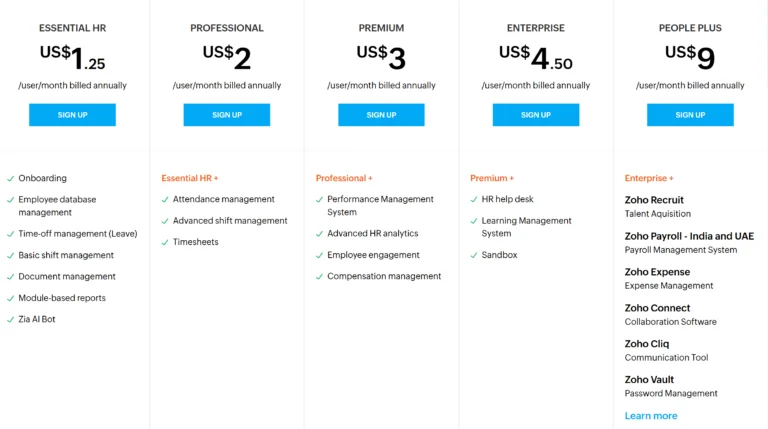
(zoho.com)
Zoho Projects
Zoho People has four pricing tiers: Free, Premium, Enterprise, and Projects Plus.
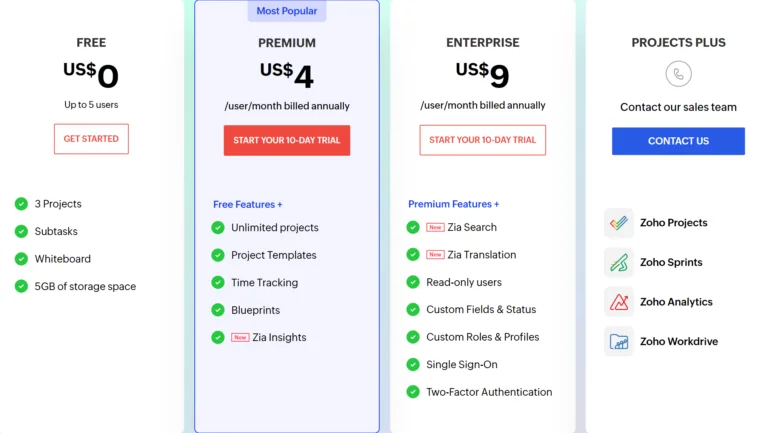
(zoho.com)
Zoho Shifts
Zoho Shifts has three pricing tiers: Free, Basic, and Standard.
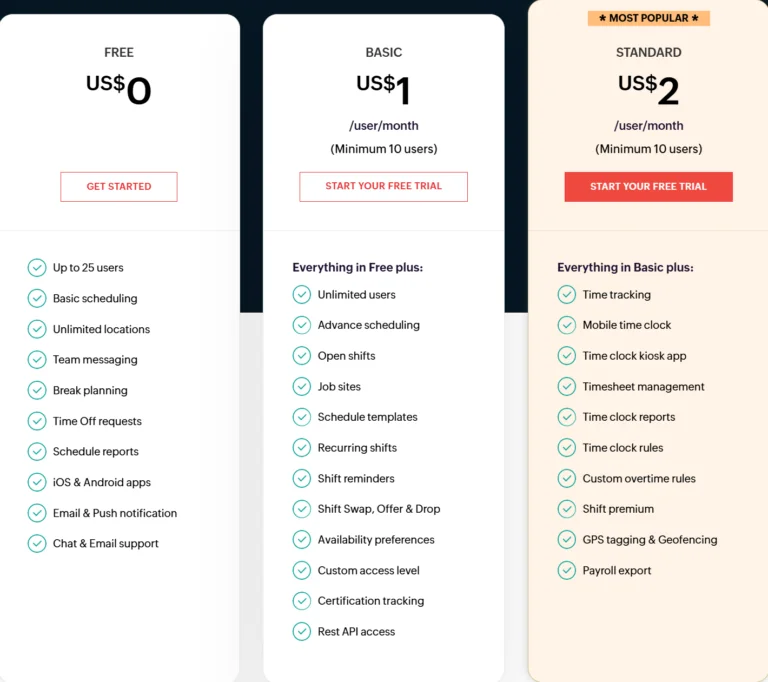
(zoho.com)
My Thoughts on Zoho’s Price
Zoho’s pricing structure across People, Projects, and Shifts is thoughtfully tiered to meet the needs of businesses at various stages of growth. Each app starts with a solid foundational set of features, and scales up with more advanced functionality features that add meaningful value – especially when used as part of the broader Zoho ecosystem.
The true strength lies in how well a company can integrate and utilize these tools together, giving greater value for money. Furthermore, when comparing Zoho’s price to its competitors, it offers pretty good value for money.
For businesses looking for flexible, scalable solutions that grow with their operational needs, Zoho offers a compelling and cost-effective suite.
For more, check out the 5 things you MUST know about Zoho’s pricing.
What are the Standout Features of Zoho?
1. Time Tracking
Zoho’s time tracking system ensures precise work-hour recording with both manual logs and automatic timers available on desktop and mobile. Employees can log time effortlessly, selecting projects, job names, billable status, and descriptions to keep teams aligned.
Bulk-logging options streamline data entry for teams, while the calendar view provides a visual way to manage time entries. The automated timer ensures hands-free tracking, making time management effortless.
By integrating directly with payroll and reporting, Zoho enhances billing accuracy and workforce transparency. While occasional mobile glitches can occur, Zoho continuously improves its platform, making it a reliable solution for tracking time with confidence.
2. Attendance Management
Zoho modernizes attendance tracking, eliminating manual errors with automated check-ins, real-time monitoring, and customizable reports. Employees can check in via mobile, on-site kiosks, facial recognition, or geo/IP-restricted logins, making it an ideal solution for both office and remote teams.
Managers gain real-time insight with detailed reports, including a daily status dashboard, overtime summaries, and attendance trends. The monthly present/absent status report offers a clear, color-coded overview, simplifying workforce tracking.
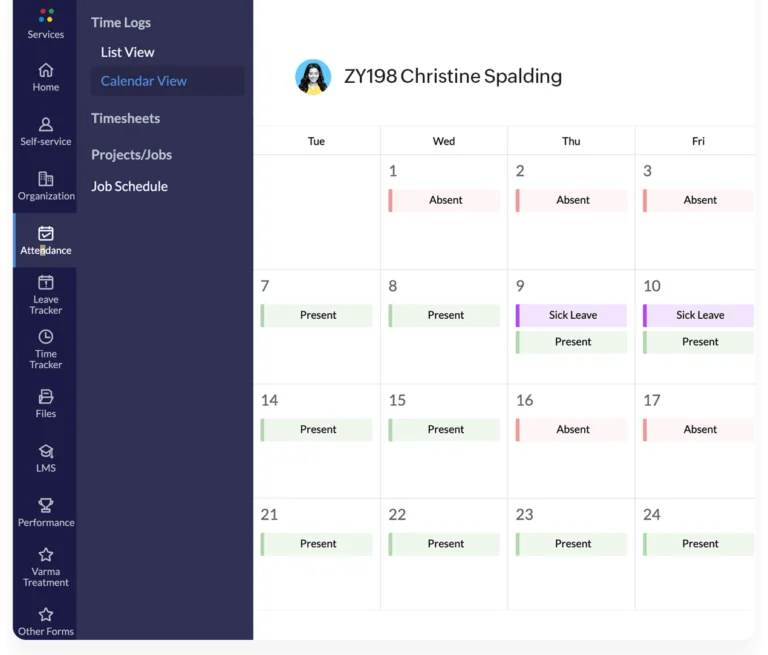
(zoho.com)
With exportable reports and attendance regularization tools, Zoho ensures seamless attendance management while keeping businesses compliant and efficient.
3. IP and Geo-restrictions
Zoho helps businesses enforce location-based attendance integrity with IP and geo-restrictions, ensuring employees clock in only from approved locations like offices, job sites, or designated remote work zones.
Admins can easily define and adjust restrictions, using an interactive map to set geofenced boundaries or restricting check-ins to approved IP ranges. Customization options allow for department-specific rules and location-based exceptions, offering both security and flexibility.
By preventing time fraud and promoting accountability, Zoho’s restrictions help businesses maintain fairness and operational efficiency.
4. Time Off Management
Zoho simplifies leave management with customizable time-off policies tailored to business needs, legal requirements, and cultural considerations. Whether tracking PTO, sick leave, maternity/paternity leave, or special requests, Zoho provides a seamless and structured approach.
The intuitive leave portal allows employees to request and track time off with ease, while managers can approve or adjust requests in a centralized dashboard. The shared time-off calendar enhances workforce planning, ensuring teams stay informed about absences and availability.
Zoho’s absence trend insights, including the Bradford score, help businesses identify patterns and manage leave proactively. Integrated payroll automation ensures that time-off adjustments are accurate and hassle-free.
With powerful customization and automation, Zoho makes managing employee leave simple, fair, and stress-free for businesses and employees alike.
Selected Positive User Feedback:
- “The flexibility it gives in terms of customization. The ease of use. I have been using Zoho Projects for a long time now. Zoho People to track performance of my associates and Zoho Cliq for internal team communication and my experience has been noting but exceptional.” – Matlob A. (Source G2)
- “I am using Zoho People from the last 1 year to manage all my personal details shared with my organization and we were make attendence through it easily and we have all information here like holidays information and attendence regularization etc” – Karan G. (Source G2)
- “Zoho People is simple to use and navigate, and it provides more customization options to meet our needs.” – Prasad (Source Capterra)
- “It is very easy to track the time working. I used it to make accountable the hours at my job. Easy as well for managers to access the info.” – Elena (Source Capterra)
- “Managing employees record is simpler and faster with Zoho people which ensures all data is a available when needed” – Claire (Source Capterra)
Selected Negative User Feedback:
- “sometimes means once in a 3 -4 months it cannot accept our picture to check in check out our attendance” – Arpit K. (Source G2)
- “Sometime in KRA section the 3 or 5 points rating system will not work instead of it NA is mentioned. In the the attendance regularisation everytime the date and time needs to be added, this is irritating.” – Pratik P. (Source G2)
- “The mobile app experience could be more polished, as some features feel less responsive compared to the desktop version.” – Daksh. (Source Capterra)
- “Zoho People can be overwhelming for new users due to its many features and customization options. Otherwise it is great to use.” – Harsh (Source Capterra)
- “App is very slow check in and check out dead slow taking more than 10 minutes for photo verification. More to come This is my experience after using the app for one week” – Suresh J. (Source Google Play)
What are Zoho’s Ratings from Review Sites?
As of March 2025
- Capterra: 4.4/5
- G2: 4.4/5
- TrustRadius: 8.8.10
- Google Play: 3.3/5
- Software Advice: 4.4/5
What’s My Final Verdict on Zoho?
Zoho is a comprehensive cloud-based software suite that caters to businesses of all sizes with over 50 different applications covering various business functions. Its time tracking capabilities, including online timesheets, automated time tracking, and real-time attendance monitoring allow for easy employee schedule management and project time and expense tracking.
In addition to that, Zoho provides advanced reporting capabilities for analyzing employee time data and making informed decisions about resource allocation and productivity. However, it doesn’t have the power, precision, and customizability that I usually like in my analytics.
Zoho offers mobile apps, integrations with third-party software, and a marketplace of extensions and add-ons. But the integrations with apps from the Zoho family seem to be spotty at times, or downright lacking – something I wouldn’t expect with apps from the same developer.
The add-ons also serve to drive the price up, and that’s not friendly for small businesses or startups on a budget.
Additionally, the calendar functionality doesn’t update in real time. And worst of all, Zoho’s iOS app is kind of the black sheep of the software. It has a dismal rating on the App Store, owing to its frequent crashes while clocking in. The Android app on the Play Store has a similar score.
Overall, I find Zoho to be a solid HR solution, but I’m not quite impressed by its time tracking features – they’re quite basic. And its iOS app is also a concern for field workers. So listen, if you’re looking for an all-in-one solution that has a bit of everything, then Zoho is for you.
But you might want to reconsider if you’re in search of a sophisticated time tracking solution.



